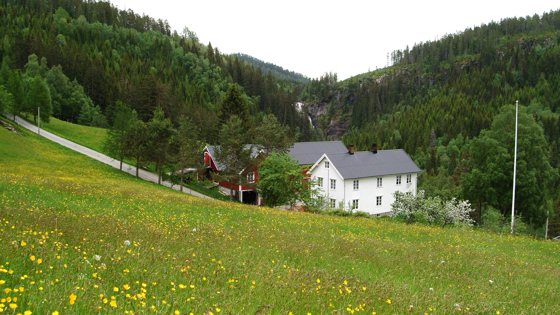Preservation of cultural landscapes
Article | Last updated: 03/12/2014 | Ministry of Agriculture and Food
Agriculture contributes to the upkeep and preservation of cultural landscapes, a significant national asset, characterized by cultural and natural diversity.

For thousands of years, human agriculture has provided a livelihood for a growing population. This activity has shaped the environment by cultivation of land, livestock grazing, and harvesting of fuel and raw materials from the forest.
This has created an environment with a wide range of assets, including domesticated plants, animals, insects and habitats, as well as cultural heritage - such as ancient buildings, burial mounds and thoroughfares.
Cultural landscapes are also important recreational areas for large segments of the population.
National heritage
The Norwegian farmer is the steward of a cultural landscape shaped by generations of use. Agriculture is thus crucial for maintaining a wide variety of traditions like building techniques, material science, crafts, customs and other featurs of the national cultural and historical heritage.
For instance, farms in Norway are the site of around one million buildings, a considerable part of Norwegian architectural heritage.
Wildlife habitats
Farmlands such as hayfields, pastures and rangelands are also habitats for a wide range of plant and animal species.
Many so-called indigenous plants and animals depend for their survival on the upkeep of farming practices, such as feed crops, grazing, burning and harvesting green-leaf forage.
Several species are in danger of extinction. Around 22 percent of all threatened and near threatened species in Norway have a substantial proportion of their populations in the present-day agricultural landscape or what is left of the former agricultural landscape.
Continuous change
Preservation of culture, heritage and biodiversity in the agricultural landscape require the continued utilization and maintainenance of farmlands.
Due to economic and technological developments, and changes in society at large, farming has been trending towards a more intensive, crop-based agriculture characterized by rationalization and efficiency.
From 1949 to 1999 the number of agricultural holdings decreased from 213.400 to 70.700. Since 1999, more than one third of the remaining farms have ceased to operate. Today there are fewer than 45.000 active farms in Norway. Several municipalities are currently without any active farms.
Where agricultural activities change or cease, the cultural landscape is also affected. Changing climate conditions will also impact these areas. Key areas become overgrown, irreplaceable heritage buildings are left to dilapidation, and species loss accellerates.
Close cooperation
In recent decades, the environmental and agricultural authorities have established a very close cooperation. Several policies to conserve the cultural landscape are in place.
Among other things, Norway was one of the first countries in Europe to establish a monitoring program for agricultural landscapes. The 3Q program was created under the auspices of the Norwegian Forest and Landscape Institute in 1998.
There is a strong popular interest in conserving the traditional landscapes of Norway's countryside.